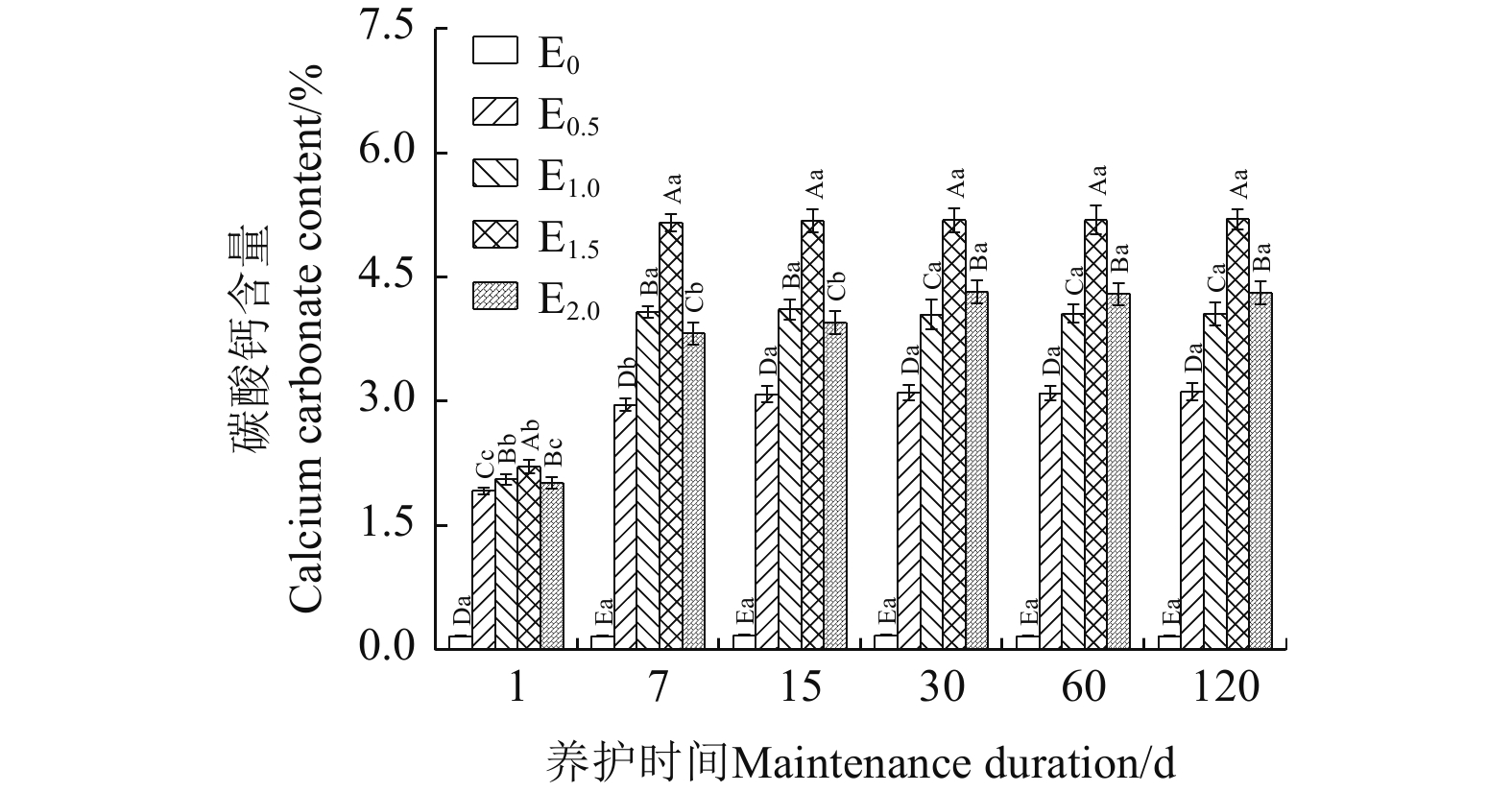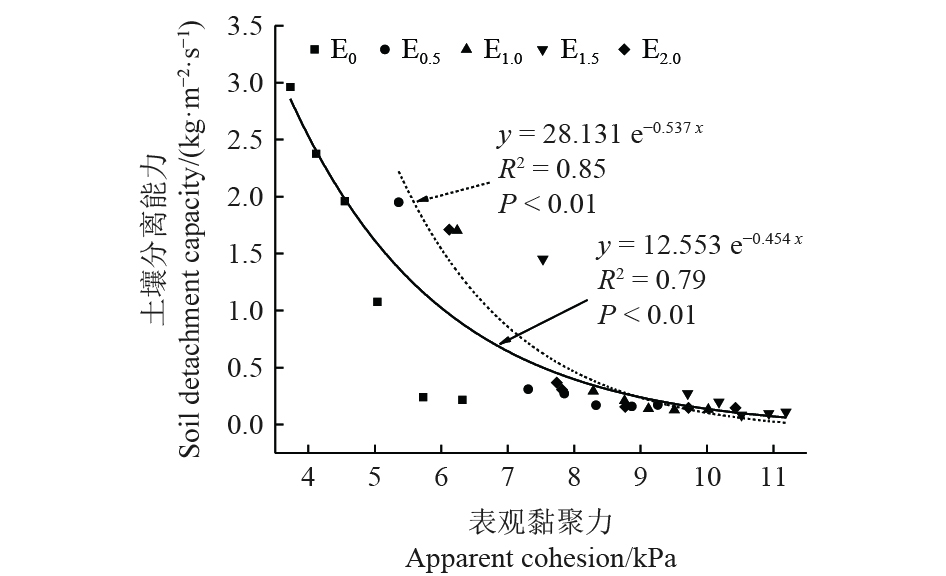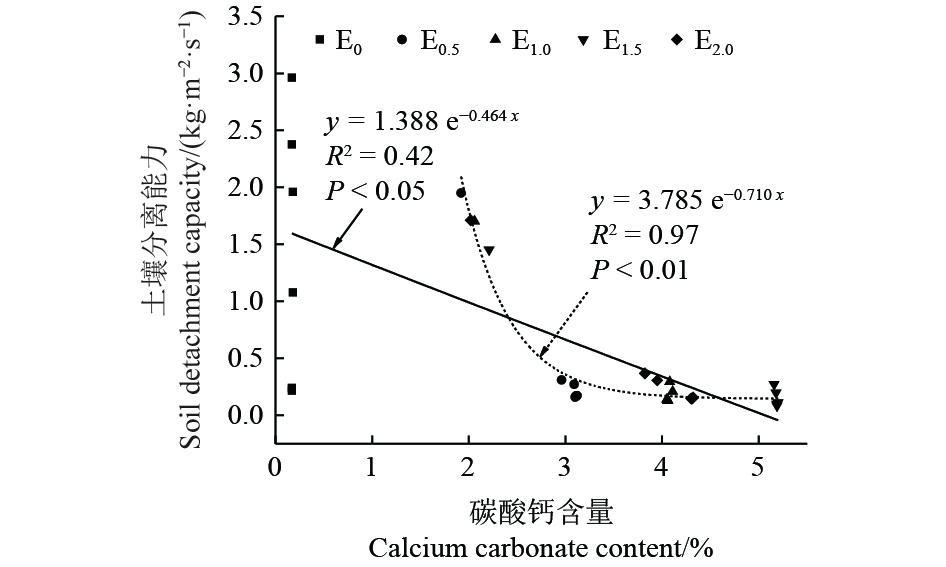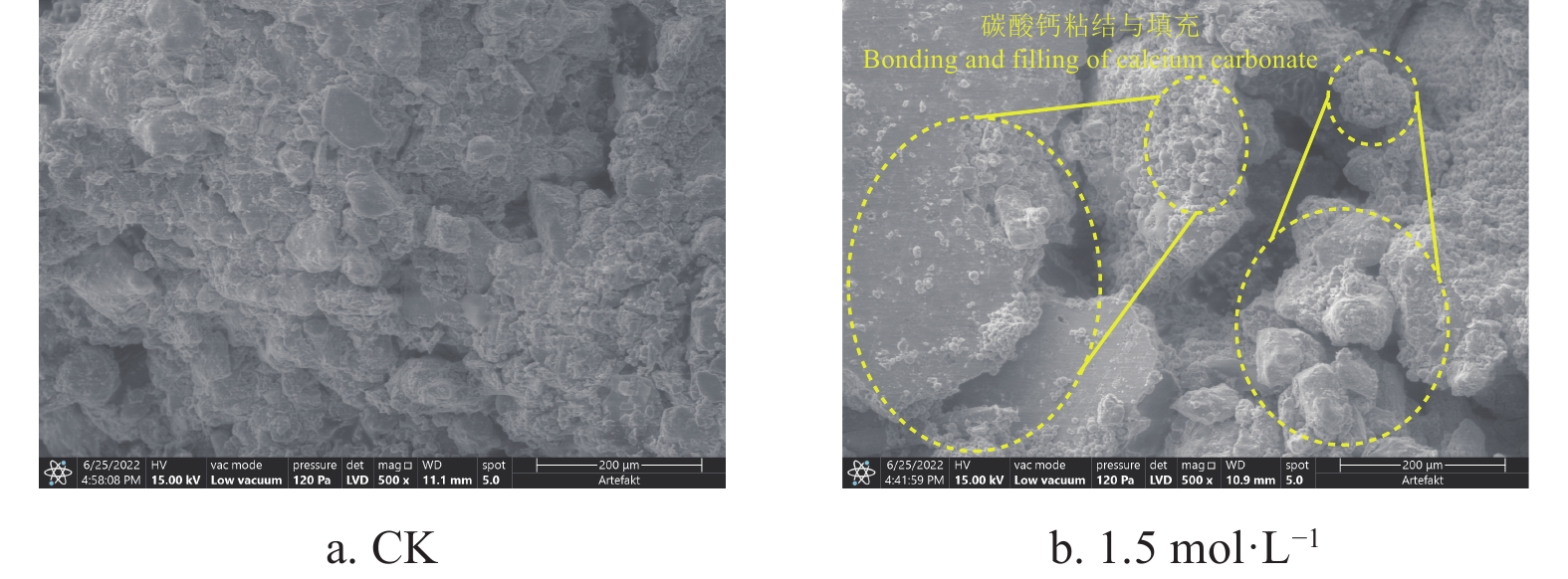Performance of enzyme-induced carbonate precipitation (EICP) for reducing soil detachment capacity of purple soil in the Three Gorges Reservoir Area
-
摘要:
为探究脲酶诱导碳酸钙沉积(enzyme-induced carbonate precipitation,EICP)减小三峡库区紫色土分离能力效果,该研究设置5个EICP浓度(0(CK对照)、0.5、1.0、1.5和2.0 mol/L)和6个养护时间(1、7、15、30、60和120 d),开展模拟冲刷试验分析土壤分离能力,通过表观黏聚力和碳酸钙含量变化阐明EICP作用下紫色土分离能力变化原因,并从微观角度揭示其减蚀机制。结果表明:与CK对照相比,EICP处理显著减小土壤分离能力,随着EICP浓度的增加,紫色土分离能力呈现先减小后增大的变化趋势,在浓度为1.5 mol/L时效果最佳;而随着养护时间的延长,紫色土分离能力呈现先快速减小再缓慢减小的变化规律,CK对照在前30天减小明显,EICP处理下在第7天时减幅明显,减幅占总减幅的85.79%~92.21%。表观黏聚力与碳酸钙含量随EICP浓度的增加先增大后减小,而随养护时间的延长分别呈持续增大和先增大后趋于稳定的变化趋势。EICP作用下紫色土碳酸钙聚集是引起分离能力降低的重要原因,表观黏聚力和碳酸钙含量与紫色土分离能力呈现显著指数函数关系(P<0.01),能够很好解释紫色土分离能力的变化。研究结果表明EICP能够有效减小紫色土分离能力,可为三峡库区水土流失治理提供理论指导。
Abstract:The Three Gorges Reservoir Area (TGRA) has often suffered the most serious soil erosion in recent years. Soil erosion control still remains on the purple soil, the main soil type for the sloping farmland in this area. Among them, enzyme-induced carbonate precipitation (EICP) can rely on the urease enzymes to catalyze urea. Specifically, the urea can be decomposed into ammonium and carbonate anions, and then precipitated the calcium carbonate (CaCO3) with the presence of carbonate anions and external calcium sources. EICP has been proven to efficiently strengthen the soil for less infiltration, in order to restore the rock and heritage. A promising approach can be regarded to effectively control soil erosion. However, the effect of EICP on the soil detachment capacity is still far from clear, especially for the response of soil detachment to the EICP concentration and maintenance time. Therefore, this study aims to clarify the effect of EICP solution concentration and maintenance duration on the soil detachment capacity of purple soil in the Three Gorges Reservoir Area. The purple soil in the TGRA was taken as the research material. The scouring experiments were conducted under five EICP solution concentrations (0 (for control check), 0.5, 1.0, 1.5, and 2.0 mol/L) at six maintenance durations (1, 7, 15, 30, 60, and 120 d), in order to estimate the soil detachment capacity. Also, the apparent cohesion and calcium carbonate content were measured at different experiment conditions. Moreover, the SEM was employed to reveal the micro-mechanism of erosion reduction by EICP. The results indicated that the soil detachment capacity of purple soil significantly decreased with the application of EICP solution. Compared with the CK, the soil detachment capacity decreased by 19.63%-86.92%, 38.79%-89.41%, 48.13%-89.91%, and 31.78%-84.49%, respectively, at the EICP solution concentration of 0.5, 1.0, 1.5 and 2.0 mol/L, with the most pronounced effect at the concentration of 1.5 mol/L. Additionally, the soil detachment capacity decreased rapidly, whereas, the subsequent slowly decreased as maintenance duration increased. Compared with the maintenance for 1 d, the decreases at 7, 15, 30, 60, and 120 d were 19.79%-84.08%, 33.81%-87.80%, 87.27%-94.21%, 91.41%-93.18%, and 91.18%-92.77%, respectively. Moreover, the reduction amplitude in the soil detachment capacity accounted for 85.79%-92.21% of the total reduction amplitude at the maintenance duration of 7 d under the application of the EICP solution. The apparent cohesion and calcium carbonate content of purple soil showed a trend of increase followed by a decrease with the increase of EICP solution concentration. Compared with the CK, the apparent cohesion increased by 43.70%-77.43%, 58.54%-101.21%, 77.06%-135.68%, and 64.08%-87.86%, respectively, at the EICP solution concentration of 0.5, 1.0, 1.5 and 2.0 mol/L, while the calcium carbonate content increased by 10.29-17.35 times, 11.12-23.00 times, 12.00-29.59 times and 10.88-24.35 times, respectively. Additionally, the apparent cohesion increased by 10.46%-36.38%, 21.98%-46.46%, 35.12%-55.41%, 45.15%-65.49%, and 48.61%-72.76%, respectively, at the maintenance for 7, 15, 30, 60 and 120 d, compared with the maintenance for 1 d. The content of calcium carbonate increased by 54.17%-133.48%, 60.94%-134.39%, 61.98%-134.84%, 61.46%-134.84%, and 62.50%-135.29%, respectively, at the maintenance for 7, 15, 30, 60 and 120 d under the application of EICP solution, compared with the stable content in the CK. The increase amplitude in the apparent cohesion and calcium carbonate content accounted for 37.59%-59.56% and 78.26%-98.66% of the total increase amplitude, respectively, at the maintenance duration of 7 d. Additionally, the microscopic analysis exposed that the soil detachment capacity was reduced to aggregate the calcium carbonate in the soil surface under the application of EICP solution. Furthermore, the soil detachment capacity was better described by the apparent cohesion and calcium carbonate content with an exponential function. The findings can provide theoretical guidance to promote erosion control in the application of EICP on soil detachment of purple soil in the TGRA.
-
Keywords:
- soils /
- erosion /
- urease /
- the Three Gorges Reservoir Area /
- purple soil /
- detachment capacity /
- EICP solution concentration
-
0. 引 言
三峡库区地理环境与地形条件较为复杂,是中国典型的生态脆弱区,面临严重水土流失问题[1]。研究表明三峡库区轻度及以上强度土壤侵蚀面积达到
25937.87 km2,占库区总面积的44.78%[2]。紫色土为三峡库区主要土地资源,是三峡库区水土流失主要策源地,在降雨、径流等侵蚀营力作用及频繁的人为活动干扰下,该区域的环境遭受严重破坏、土壤强度明显下降,造成严重侵蚀[3],产生大量泥沙淤积在库区,严重威胁三峡工程运行安全。分离是土壤侵蚀的初始阶段,土壤分离能力是评价土壤侵蚀过程与确定土壤侵蚀阻力的基本参数[4]。土壤分离能力是指坡面径流含沙量为0时在单位时间对单位面积上土壤的分离量,是该径流分离土壤的最大速率[5],受土壤颗粒分布、黏结力、生物结皮、植被覆盖等因素的影响[6-8]。生物措施能够有效减少土壤分离能力,如:WANG等[9]研究表明自然恢复下的弃耕地相比耕地的土壤分离能力降低了95.74%~98.14%;牛耀彬等[10]发现植物覆盖可将堆积体坡面土壤分离能力降低94.97%;WANG等[11]发现植物凋落物与根系结合可将裸坡的土壤分离能力减小55%;张冠华等[12]研究表明生物结皮覆盖下土壤分离能力相较裸土减小了49.38%~95.00%。然而,这些研究均是在植物或生物结皮发育后进行,实际上植物或生物结皮发育需要较长的时间,在初期难以发挥固土减蚀效果,此时仍需快速高效的措施以降低土壤分离能力,提高土体抗侵蚀能力。
微生物诱导碳酸钙沉积(microbial induced calcite precipitation, MICP)和脲酶诱导碳酸钙沉积(enzyme-induced carbonate precipitation,EICP)技术是近年来基于学科交叉发展起来的一种节能环保技术,其核心是利用酶诱导产生具有胶结作用的矿物结晶从而实现对岩土体加固,并具有良好的水土保持效果[13]。有研究表明MICP可将紫色土的崩解率降低73%~97%,并使平均崩解速率下降84%~99%[14]。程瑶佳等[15]发现MICP作用下降雨对黄土的最大侵蚀速率出现时间由12 min延长至88 min。邵光辉等[16]发现MICP作用下粉土坡面的抗侵蚀性随着胶结液浓度的增加明显增强,在1.0 mol/L时效果达到最好。此外,部分研究发现EICP对降雨侵蚀、波浪侵蚀和风蚀均具有极大的抑制作用,如:SHEN等[17]研究表明,浓度为1.0 mol/L的EICP溶液可将降雨侵蚀产生的时间延迟8 min,显著提高了黄土边坡的抗侵蚀性;张建伟等[18]发现浓度为0.75 mol/L的EICP溶液与木质素联合作用能够减小粉土边坡75%的降雨侵蚀量;ALMAJED等[19]利用不同浓度的EICP溶液处理砂土,发现当EICP浓度为1.25 mol/L时砂土的风蚀率降幅最大可达100%;LIU等 [20]表明在浓度为0.25和0.5 mol/L的EICP溶液作用下波浪侵蚀分别降低了30%和71%。可见,EICP的减蚀效果会因浓度不同而存在显著差异。同时,相关研究表明EICP加固土体存在时间效应,如:王欢等[21]发现EICP加固膨胀土的碳酸钙含量随养护时间增加而增加,而无侧限抗压强度也随之增加;原华等[22]发现随着养护时间的增加EICP加固粉土的无侧限抗压强度在7 d内显著提升,且随着时间的延长持续增加。可见,养护时间对EICP加固效果具有明显影响,因而也可能影响其减蚀效果。然而目前关于不同EICP浓度处理与养护时间下土壤分离能力的变化规律尚不清楚。
因此,为明确EICP对三峡库区紫色土分离能力的影响,本研究以三峡库区紫色土为研究对象,设置不同EICP浓度(0、0.5、1.0、1.5和2.0 mol/L)和不同养护时间(1、7、15、30、60和120 d),通过模拟冲刷试验探究紫色土分离能力对EICP浓度和养护时间的响应规律,并尝试从表观黏聚力和碳酸钙含量的角度揭示土壤分离能力动态演变的原因,最后利用环境扫描电镜揭示其微观机制,以期为三峡库区水土流失治理提供理论依据。
1. 材料与方法
1.1 供试土壤和试验材料
以三峡库区典型紫色土为研究对象,所用土壤取自湖北省宜昌市秭归县(110°18'~111°0'E、30°38'~31°11'N)坡地0~30 cm表层。将采集的土壤运至三峡大学地质灾害教育部重点实验室风干后过5 mm筛以剔除块石、根系等杂质。经测定,风干含水率为4.77%,容重为1.30 g/cm3,pH值为6.87,有机质含量为6.75 g/kg,黏粒(<0.002 mm)占16.50%、细粉粒(0.002~0.020 mm)占25.65%、粗粉粒(>0.020~0.050 mm)占12.79%和砂粒(>0.050~2.000 mm)占45.06%,土壤质地为壤土。
EICP反应过程中需要大豆脲酶、尿素与氯化钙,其中大豆脲酶作为尿素水解催化物,尿素与氯化钙分别用于EICP反应过程中提供碳酸根与钙离子[23-24]。尿素(分析纯)与氯化钙(分析纯)均为国药集团化学试剂有限公司生产的固体粉末。大豆脲酶采用吴林玉等[25]方法制得,大致过程为:先将干燥大豆打成粉末备用,随后称取60 g豆粉倒入1 L蒸馏水中用磁力搅拌器搅拌30 min,之后在4 ℃温度下静置24 h,最终将豆粉溶液在离心机中用
3000 r/min转速离心15 min得到脲酶溶液,将脲酶溶液置于低温储存室在4 ℃下进行保存。采用电导率法[17](DDS-11A 型电导率仪)多次测得脲酶溶液活性为(7.2±0.1) mmol/min。其次,将等物质的量浓度的尿素与氯化钙混合以配制成不同浓度的胶凝液,随后考虑反应效果,将所得胶凝液与等体积(1∶1)脲酶溶液均匀混合获得不同浓度的EICP溶液[25],用于后续研究。1.2 试验设计
考虑EICP浓度与反应时间对碳酸钙生成的影响[26-27],本研究设置5种EICP溶液浓度(0(CK对照)、0.5、1.0、1.5和2.0 mol/L分别编号为:E0、E0.5、E1.0、E1.5和E2.0),并分别经6个养护时间(1、7、15、30、60和120 d)后进行冲刷试验以探究不同EICP浓度和养护时间对紫色土分离能力的影响。此外,根据GUO等[28]并结合实地调查,设置坡度46.6%、径流量30 L/min开展冲刷试验。试验采用模拟冲刷水槽(长×宽×高为5.0 m×0.4 m×0.3 m),水槽尾端设置稳流池(长×宽×深为0.4 m×0.4 m×0.5 m)确保试验过程中得到稳定持续的水流(图1)。
采用长方体试样箱(长×宽×高为0.70 m×0.45 m×0.20 m)进行相关试样的制备与养护,箱体底部开孔(孔径0.5 cm)用于排水。采用分层装填方式装填15 cm厚土壤(5 cm每层,共3层),并在每层间拉毛处理以防止层间不连续[29]。首先,在固定质量的紫色土中分别加入相当于土壤质量20%含水率的不同浓度EICP溶液,经过10 min充分拌合后装填至试样箱中以防止拌合时间过长影响试验效果。然后,覆盖无纺布进行养护,以待后续试验取样。为保证试验准确性,每组取样重复3次,取平均值作为最终数据。
1.3 试验过程
用自制环刀(直径10.05 cm,高5 cm)进行取样[29],随后对环刀试样进行饱和处理以模拟产流状态下试样真实状态以及消除前期含水率的影响[30]。试验前使用坡度仪将冲刷水槽坡度调整至46.6%,然后将所取试样放入置样口并使用密封盖覆盖保护,以防止流量调节过程中水流对试样的冲刷,随后往稳流池中注水并调节水流流量至30 L/min(误差小于5%)。待冲刷槽内水流稳定后取下密封盖开始试验,观察试样冲刷至距表面2 cm深处停止试验,记录冲刷试验时长;若试样抗冲蚀性能较好,则冲刷时间设置为500 s[31]。收集各冲刷试验的所有径流泥沙样并静置24 h以上,之后将上层清液倒掉并将所得泥沙转移至烘箱内烘干称质量用于计算土壤分离能力。同时,试验开始前在试样箱内表面随机位置利用微剪仪(mD mVST A型,广州默德精密仪器有限公司)测定土壤表观黏聚力[29],并在不同位置取样用酸洗法[25]测定碳酸钙含量。上述试验每组试样至少重复3次。此外,将养护时长为7 d时对照组和EICP浓度为1.5 mol/L处理的试样进行风干处理,随机选取直径5 mm左右的试块置于扫描电镜的圆形固定台上用导电胶固定,并在样品表面进行喷金处理,之后利用环境扫描电镜(Prisma E型,美国赛默飞世尔科技公司)观察微观形态以从微观角度揭示EICP作用下紫色土分离能力的微观机制。
1.4 数据处理与统计分析
根据试样所获得的冲刷样干质量,利用式(1)计算土壤分离能力(Dr),一般来说,同一水力条件下,Dr数值越大表明土壤抗侵蚀性越差。
Dr=ErS⋅t (1) 式中Er为试样所收集到的泥沙样干质量,kg;S为环刀横截面积,m2;t为试样冲刷时间,s。
碳酸钙含量通过酸洗前后质量差确定,利用式(2)计算:
C=M1−M2M1×100% (2) 式中C为碳酸钙含量,%;M1为试样酸洗前质量,g;M2为试样酸洗后质量,g。
采用Excel 2019进行数据处理,通过SPSS 24.0进行显著性与多因素方差分析,利用Origin 2023进行图形绘制。
2. 结果与分析
2.1 土壤分离能力
土壤分离能力受EICP浓度和养护时间影响明显,方差分析表明:EICP浓度和养护时间的单一作用和两者交互作用均对土壤分离能力产生极显著影响(P<0.001),根据F值,养护时间影响最大,EICP浓度次之,二者交互作用影响最小(表1)。
表 1 脲酶诱导碳酸钙沉积EICP浓度和养护时间对紫色土分离能力、表观黏聚力和碳酸钙含量影响方差分析Table 1. Analysis of variance (ANOVA) of enzyme-induced carbonate precipitation (EICP) solution concentrations and maintenance durations on soil detachment capacity, apparent cohesion and calcium carbonate content参数
ParametersF值F value EICP浓度(CC)
EICP solution concentration养护时间(TT)
Maintenance durationCC×TT 土壤分离能力
Soil detachment capacity1606.78 **3008.41 **191.95** 表观黏聚力
Apparent cohesion517.37** 202.05** 3.03** 碳酸钙含量
Calcium carbonate content3880.78 **454.67** 31.39** 注:**,P<0.01。下同。Note: **,P<0.01.Same as below. 由图2可知,土壤分离能力随EICP浓度的增加呈现先减小后增大的变化规律。与CK对照组相比,EICP可显著减小土壤分离能力(P<0.01),EICP浓度为0.5、1.0、1.5和2.0 mol/L时紫色土分离能力分别减小19.63%~86.92%、38.79%~89.41%、48.13%~89.91%和31.78%~84.49%,在浓度为1.5 mol/L时减小效果最好。土壤分离能力随养护时间的延长呈现持续减小的变化规律,且前期减小幅度较大。与养护时间为1 d相比,养护时间为7、15、30、60和120 d时紫色土分离能力分别减小19.79%~84.08%、33.81%~87.80%、87.27%~94.21%、91.41%~93.18%和91.18%~92.77%。CK对照组在前30 天减幅较大,随后逐渐趋于稳定;而EICP处理组在第7天时分离能力即降低到较低水平,之后随养护时间增加土壤分离能力减幅较小。在养护时间为7 d时,EICP作用下土壤分离能力的减幅达到总减幅的85.79%~92.21%,在浓度为0.5、1.0、1.5和2.0 mol/L时分别达到92.21%、89.62%、87.97%和85.79%,说明EICP处理能够快速提高土壤抗侵蚀能力。
![]() 图 2 不同EICP浓度与养护时间下土壤分离能力变化注:不同大写字母表示相同养护时间下不同EICP浓度差异显著(P<0.01);不同小写字母表示相同EICP浓度下不同养护时间差异显著(P<0.01);E0~E2.0分别表示EICP浓度为0、0.5、1.0、1.5和2.0 mol·L−1;下同。Figure 2. Variations of soil detachment capacity under different EICP solution concentration and maintenance durationNote: The different capital letters indicate the significance differences among different EICP solution concentration under the same maintenance duration (P<0.01), and the different lowercase letters indicate the significance differences among different maintenance duration under the same EICP solution concentration (P<0.01); E0-E2.0 indicate the EICP solution concentration is 0, 0.5, 1.0, 1.5 and 2.0 mol·L−1; the same below.
图 2 不同EICP浓度与养护时间下土壤分离能力变化注:不同大写字母表示相同养护时间下不同EICP浓度差异显著(P<0.01);不同小写字母表示相同EICP浓度下不同养护时间差异显著(P<0.01);E0~E2.0分别表示EICP浓度为0、0.5、1.0、1.5和2.0 mol·L−1;下同。Figure 2. Variations of soil detachment capacity under different EICP solution concentration and maintenance durationNote: The different capital letters indicate the significance differences among different EICP solution concentration under the same maintenance duration (P<0.01), and the different lowercase letters indicate the significance differences among different maintenance duration under the same EICP solution concentration (P<0.01); E0-E2.0 indicate the EICP solution concentration is 0, 0.5, 1.0, 1.5 and 2.0 mol·L−1; the same below.2.2 表观黏聚力
表观黏聚力受EICP浓度和养护时间的显著影响,方差分析表明:EICP浓度和养护时间的单一作用和两者交互作用均对表观黏聚力产生极显著影响(P<0.001),且EICP浓度对其影响最大,其次为养护时间,最后是二者交互作用(表1)。表观黏聚力随EICP浓度的增加呈现先增大后减小的变化趋势(图3)。与CK对照组相比,EICP作用下表观黏聚力显著增大(P<0.01),EICP浓度为0.5、1.0、1.5和2.0 mol/L时表观黏聚力分别增加43.70%~77.43%、58.54%~101.21%、77.06%~135.68%和64.08%~87.86%,在浓度为1.5 mol/L时数值最大。此外,表观黏聚力随养护时间的延长呈现持续增大的变化趋势,且前期增长幅度较大。与养护时间为1 d相比,养护时长为7、15、30、60和120 d时表观黏聚力分别增加10.46%~36.38%、21.98%~46.46%、35.12%~55.41%、45.15%~65.49%和48.61%~72.76%。CK对照组随养护时间增长持续增加,但增长幅度相对较小;EICP组随着养护时间的增加持续增加,且在初期增幅较大,在养护时间为7 d时,EICP作用下表观黏聚力的增幅达到总增幅的37.59%~59.56%,在浓度为0.5、1.0、1.5和2.0 mol/L时分别达到50.00%、54.23%、59.56%和37.59%,表明EICP处理能够迅速提高土壤表观黏聚力。
2.3 碳酸钙含量
碳酸钙含量受EICP浓度与养护时间的显著影响,方差分析表明:EICP浓度和养护时间的单一作用和两者交互作用均对碳酸钙含量产生极显著影响(P<0.001),根据F值,EICP浓度影响最大,其次为养护时间,而二者交互作用影响最小(表1)。碳酸钙含量随EICP浓度的增加呈现先增大后减小的变化趋势(图4)。
与CK对照组相比,EICP显著增加碳酸钙含量(P<0.01),EICP浓度为0.5、1.0、1.5和2.0 mol/L时碳酸钙含量分别增加10.29~17.35倍、11.12~23.00倍、12.00~29.59倍和10.88~24.35倍,在浓度为1.5 mol/L时增加效果最好。此外,碳酸钙含量随养护时间的延长呈现先增大后趋于稳定的变化趋势。与养护时间为1 d相比,CK对照组碳酸钙含量基本不变,EICP处理下,养护时长为7、15、30、60和120 d时试样碳酸钙含量分别增长54.17%~133.48%、60.94%~134.39%、61.98%~134.84%、61.46%~134.84%和62.50%~135.29%。养护时间为7 d时,在EICP作用下碳酸钙含量增长幅度分别达到总增长幅度的78.26%~98.66%,在浓度为0.5、1.0、1.5和2.0 mol/L时分别为86.67%、98.54%、98.66%和78.26%,表明EICP处理可迅速增加土壤碳酸钙含量。
2.4 紫色土分离能力与表观黏聚力和碳酸钙含量的关系
拟合分析表明(图5和图6),土壤分离能力与表观黏聚力和碳酸钙含量均呈显著的指数函数关系(P<0.05),二者的决定系数R2分别为0.79和0.42。考虑CK对照组表观黏聚力和碳酸钙含量变化不大会影响拟合结果,剔除CK组数据后,EICP作用下土壤分离能力与表观黏聚力和碳酸钙含量亦均呈显著的指数函数关系(P<0.01),且二者的决定系数R2均有明显增加,分别为0.85和0.97,表明表观黏聚力和碳酸钙含量变化可分别解释EICP处理下85%和97%的土壤分离能力变化。其中,描述碳酸钙含量与土壤分离能力函数的决定系数相对更高,可作为预测紫色土分离能力的重要指标。
![]() 图 5 土壤分离能力与表观黏聚力的关系注:图中实线表示所有数据的拟合关系,虚线表示剔除CK组数据的拟合关系。下同。Figure 5. Relationship between the soil detachment capacity and the apparent cohesionNote: The solid line represents the fitting relationship by using all data, while the dashed line represents the fitting relationship after deleting the CK group data; the same below.
图 5 土壤分离能力与表观黏聚力的关系注:图中实线表示所有数据的拟合关系,虚线表示剔除CK组数据的拟合关系。下同。Figure 5. Relationship between the soil detachment capacity and the apparent cohesionNote: The solid line represents the fitting relationship by using all data, while the dashed line represents the fitting relationship after deleting the CK group data; the same below.3. 讨 论
相比于CK对照组,EICP处理下土壤分离能力显著下降,这与张建伟等[18]在降雨条件下研究EICP对土壤侵蚀量的影响结果一致,这与EICP反应生成的碳酸钙对土壤进行胶结与填充密切相关[32]。在EICP作用下,土壤的表观黏聚力与碳酸钙含量均显著增加(图3和图4),因而提高土体强度和抗冲刷能力,从而导致土壤分离能力显著降低。此外,随着EICP浓度的增加,土壤分离能力呈现先减小后增大的变化趋势,这与OSSAI 等[33]减少砂质土壤径流侵蚀结果一致。一方面,随着EICP浓度增加,施加的氯化钙也随之增加,氯化钙的电化学作用在一定程度上可以加固土体[34],另一方面,经EICP处理后在土体中形成碳酸钙沉淀,在其胶结作用下土体强度得到进一步提升。随着EICP浓度的增加,电化学作用持续增强,但过高的尿素浓度会抑制脲酶活性,从而一定程度抑制EICP反应过程,导致碳酸钙生成量减少,造成加固效果降低[35]。当尿素浓度过高时,电化学作用对土壤抗冲刷能力的提升程度小于因脲酶活性抑制而导致的EICP加固效果减弱,因此在浓度为2.0 mol/L时,土体的加固效果相较于1.5 mol/L时变差,从而出现土壤分离能力先减小后增大的现象。
随着养护时间的延长,土壤分离能力呈现先快速减小后缓慢减小的变化规律,而表观黏聚力持续增大。这主要与养护过程中自然沉降和雨滴打击在表面形成结皮密切相关[29],导致表观黏聚力的持续增大(图3),进而减小了土壤分离能力。相比于CK对照组,EICP处理能够迅速提高土壤抗侵蚀能力。在EICP处理下,土壤分离能力在7 d内迅速降至较低水平,其降幅达到总减小幅度的85.79%~92.21%,随后呈缓慢下降趋势,这与原华等[22]对EICP加固粉土随养护时长变化规律基本一致。有研究表明土壤在水流冲刷过程中将以团聚体的形式发生迁移,且小团聚体更容易被剥离[36],在养护初期,脲酶活性较高,在脲酶作用下碳酸钙在7 d内迅速生成(图4),从而为团聚体提供填充与桥接,使团聚体更加密实并相互粘结形成大团聚体,因而土壤抗冲刷能力更强,导致土壤分离能力迅速降低。之后脲酶活性持续降低[37],EICP反应生成碳酸钙进程变缓,同时在自然沉降与雨滴持续打击作用下,表观黏聚力持续缓慢增加,造成土壤分离能力减幅变缓。
对养护时间为7 d时的CK对照组和EICP浓度为1.5 mol/L处理下紫色土的微观形态进行分析,发现EICP改变了紫色土的表面形态(图7)。
CK对照组基本以小团聚体为主,而EICP处理下紫色土颗粒表面出现碳酸钙聚集现象,这一方面填充土壤孔隙,增加土壤的致密性,另一方面在碳酸钙粘结作用下小团聚体团聚成更加稳定的团聚结构,导致表观黏聚力的增强,从而降低了土壤分离能力。此外,根据拟合分析结果来看,土壤分离能力与表观黏聚力和碳酸钙含量均具有显著的指数函数关系,在EICP处理后,两者均能够揭示85%以上的土壤分离能力变化,其中碳酸钙含量能够解释更多的土壤分离变化,后续可将其作为EICP处理后紫色土分离能力的重要预测指标。
4. 结 论
本研究以三峡库区紫色土为研究对象,探究了不同EICP浓度和养护时间下紫色土分离能力、表观黏聚力和碳酸钙含量变化规律,通过表观黏聚力和碳酸钙含量变化解释了紫色土分离能力变化原因,并从微观角度揭示了其微观机制。主要结论如下:
1)随着EICP浓度的增加,紫色土分离能力呈现先减小后增大的变化趋势,而表观黏聚力和碳酸钙含量均呈现先增大后减小的变化趋势,均在浓度为1.5 mol/L时效果最好。
2)随着养护时间的延长,紫色土分离能力持续减小,且在EICP作用下呈现先迅速减小后缓慢减小的变化趋势,在养护时间为7 d时减幅达到总减幅的85.79%~92.21%,表观黏聚力持续增大而碳酸钙含量先增大后趋于稳定,且养护时间为7 d时在EICP作用下增幅分别达到总增幅的37.59%~59.56%和78.26%~98.66%。
3)微观形态表明EICP改变了紫色土的表面形态,在土壤颗粒表面出现碳酸钙聚集现象,同时表观黏聚力和碳酸钙含量能够很好地解释紫色土分离能力变化,其中碳酸钙含量能够解释更多的土壤分离变化,后续可将其作为EICP处理后紫色土分离能力的重要预测指标。
-
图 2 不同EICP浓度与养护时间下土壤分离能力变化
注:不同大写字母表示相同养护时间下不同EICP浓度差异显著(P<0.01);不同小写字母表示相同EICP浓度下不同养护时间差异显著(P<0.01);E0~E2.0分别表示EICP浓度为0、0.5、1.0、1.5和2.0 mol·L−1;下同。
Figure 2. Variations of soil detachment capacity under different EICP solution concentration and maintenance duration
Note: The different capital letters indicate the significance differences among different EICP solution concentration under the same maintenance duration (P<0.01), and the different lowercase letters indicate the significance differences among different maintenance duration under the same EICP solution concentration (P<0.01); E0-E2.0 indicate the EICP solution concentration is 0, 0.5, 1.0, 1.5 and 2.0 mol·L−1; the same below.
图 5 土壤分离能力与表观黏聚力的关系
注:图中实线表示所有数据的拟合关系,虚线表示剔除CK组数据的拟合关系。下同。
Figure 5. Relationship between the soil detachment capacity and the apparent cohesion
Note: The solid line represents the fitting relationship by using all data, while the dashed line represents the fitting relationship after deleting the CK group data; the same below.
表 1 脲酶诱导碳酸钙沉积EICP浓度和养护时间对紫色土分离能力、表观黏聚力和碳酸钙含量影响方差分析
Table 1 Analysis of variance (ANOVA) of enzyme-induced carbonate precipitation (EICP) solution concentrations and maintenance durations on soil detachment capacity, apparent cohesion and calcium carbonate content
参数
ParametersF值F value EICP浓度(CC)
EICP solution concentration养护时间(TT)
Maintenance durationCC×TT 土壤分离能力
Soil detachment capacity1606.78 **3008.41 **191.95** 表观黏聚力
Apparent cohesion517.37** 202.05** 3.03** 碳酸钙含量
Calcium carbonate content3880.78 **454.67** 31.39** 注:**,P<0.01。下同。Note: **,P<0.01.Same as below. -
[1] XIAO H, GUO P, ZHANG Q H, et al. Variation in soil properties and its influence on the dynamic change of soil erosion resistance to overland flow in the water-level fluctuation zone of the Three Gorges Reservoir, China[J]. Catena, 2022, 213: 106141. doi: 10.1016/j.catena.2022.106141
[2] 王铭烽. 三峡库区水库运行前后土壤侵蚀动态变化及人为驱动机制[D]. 北京:中国科学院大学,2021. WANG Mingfeng. Dynamic Changes and Human Drivers of Soil Erosion Before and After Reservoir Operation in the Three Gorges Reservoir Area[D]. Beijing: University of Chinese Academy of Sciences, 2021. (in Chinese with English abstract)
[3] 肖海,王地,夏振尧,等. 植物篱对紫色土坡面侵蚀泥沙粒径分布特征的影响[J]. 农业工程学报,2023,39(19):58-66. XIAO Hai, WANG Di, XIA Zhenyao, et al. Influence of hedgerows on the particle size distribution of eroded sediment on purple soil slope[J]. Transactions of the Chinese Society of Agricultural Engineering (Transactions of the CSAE), 2023, 39(19): 58-66. (in Chinese with English abstract).
[4] 孙宝洋,吴志广,李占斌,等. 冻融对土壤分离能力及侵蚀阻力的影响[J]. 农业工程学报,2020,36(11):57-65. SUN Baoyang, WU Zhiguang, LI Zhanbin, et al. Effects of freeze-thaw on soil detachment capacity and erosion resistance[J]. Transactions of the Chinese Society of Agricultural Engineering (Transactions of the CSAE), 2020, 36(11): 57-65. (in Chinese with English abstract)
[5] 张光辉. 土壤分离能力测定的不确定性分析[J]. 水土保持学报,2017,31(2):1-6. ZHANG Guanghui. Uncertainty analysis of soil detachment capacity measurement[J]. Journal of Soil and Water Conservation, 2017, 31(2): 1-6. (in Chinese with English abstract)
[6] 李桂,曹文华,马建业,等. 小麦秸秆覆盖量对坡面流水动力学特性影响[J]. 农业工程学报,2023,39(1):108-116. doi: 10.11975/j.issn.1002-6819.202207186 LI Gui, CAO Wenhua. MA Jianye, et al. Effect of wheat straw mulch on slope hydrodynamic characteristics[J]. Transactions of the Chinese Society of Agricultural Engineering (Transactions of the CSAE), 2023, 39(1): 108-116. (in Chinese with English abstract) doi: 10.11975/j.issn.1002-6819.202207186
[7] LIU F, ZHANG G H, SUN L, et al. Effects of biological soil crusts on soil detachment process by overland flow in the Loess Plateau of China[J]. Earth Surface Processes and Landforms, 2016, 41(7): 875-883. doi: 10.1002/esp.3870
[8] LI Z W, ZHANG G H, GENG R, et al. Land use impacts on soil detachment capacity by overland flow in the Loess Plateau, China[J]. Catena, 2015, 124: 9-17. doi: 10.1016/j.catena.2014.08.019
[9] WANG B, ZHANG G H, SHI Y Y, et al. Soil detachment by overland flow under different vegetation restoration models in the Loess Plateau of China[J]. Catena, 2014, 116: 51-59. doi: 10.1016/j.catena.2013.12.010
[10] 牛耀彬,高照良,齐星圆,等. 不同工程堆积体坡面治理措施对土壤抗冲刷侵蚀能力的影响[J]. 农业工程学报,2019,35(2):134-143. NIU Yaobin, GAO Zhaoliang, QI Xingyuan, et al. Effects of treatment measures on soil anti-scour erodibility in engineering accumulation slope[J]. Transactions of the Chinese Society of Agricultural Engineering (Transactions of the CSAE), 2019, 35(2): 134-143. (in Chinese with English abstract)
[11] WANG D D, YU X X, JIA G D, et al. The effects of Pinus tabuliformis on soil detachment under different influencing factors in the Loess Plateau of China[J]. Chemistry and Ecology, 2018, 34(5): 439-453. doi: 10.1080/02757540.2018.1433169
[12] 张冠华,易亮,丁文峰,等. 三峡库区生物结皮对土壤分离过程的影响及其机制[J]. 土壤,2021,53(3):610-619. ZHANG Guanhua, YI Liang, DING Wenfeng, et al. Effects and mechanism of biocrusts on soil detachment process by overland flow in the Three Gorges Reservoir Area[J]. Soils, 2021, 53(3): 610-619. (in Chinese with English abstract)
[13] SUN X H, MIAO L C, WANG H X, et al. Mineralization crust field experiment for desert sand solidification based on enzymatic calcification[J]. Journal of Environmental Management, 2021, 287: 112315. doi: 10.1016/j.jenvman.2021.112315
[14] 黎桉君,许冲,李贤,等. 非饱和砂质黏性紫色土崩解特性及MICP加固试验[J]. 农业工程学报,2021,37(22):127-135. LI Anjun, XU Chong, LI Xian, et al. Experimental investigation on disintegration characteristics and MICP reinforcement of unsaturated sandy clayey purple soil[J]. Transactions of the Chinese Society of Agricultural Engineering (Transactions of the CSAE), 2021, 37(22): 127-135. (in Chinese with English abstract)
[15] 程瑶佳,唐朝生,泮晓华,等. 微生物矿化作用(MICP)-铺砂联合提高黄土抗侵蚀性试验研究[J]. 防灾减灾工程学报,2022,42(5):1010-1018. CHENG Yaojia, TANG Chaosheng, PAN Xiaohua, et al. Experimental study on erosion resistance improvement in Loess through coupled microbial mineralization (MICP)-sand paving[J]. Journal of Disaster Prevention and Mitigation Engineering, 2022, 42(5): 1010-1018. (in Chinese with English abstract)
[16] 邵光辉,冯建挺,赵志峰,等. 微生物砂浆防护粉土坡面的强度与抗侵蚀性影响因素分析[J]. 农业工程学报,2017,33(11):133-139. SHAO Guanghui, FENG Jianting, ZHAO Zhifeng, et al. Influence factor analysis related to strength and anti-erosion stability of silt slope with microbial mortar protective covering[J]. Transactions of the Chinese Society of Agricultural Engineering (Transactions of the CSAE), 2017, 33(11): 133-139. (in Chinese with English abstract)
[17] SHEN D Y, LIU Z Y, SONG C Z, et al. Reinforcement mechanism and erosion resistance of loess slope using enzyme induced calcite precipitation technique[J]. Sustainability, 2023, 15(2): 1044. doi: 10.3390/su15021044
[18] 张建伟,钱思羽,王小锯,等. EICP联合木质素改性粉土边坡对抗雨蚀试验研究[J]. 河海大学学报(自然科学版),2024,52(1):70-76. ZHANG Jianwei, QIAN Siyu, WANG Xiaoju, et al. Experimental study on rain erosion resistance of EICP combined with lignin modified silt slope[J]. Journal of Hohai University (Natural Sciences), 2024, 52(1): 70-76. (in Chinese with English abstract)
[19] ALMAJED A, LEMBOYE, K, ARAB, M G, et al. Mitigating wind erosion of sand using biopolymer-assisted EICP technique[J]. Soils and Foundations, 2020, 60(2): 356-371. doi: 10.1016/j.sandf.2020.02.011
[20] LIU K W, JIANG N J, QIN J D, et al. An experimental study of mitigating coastal sand dune erosion by microbial- and enzymatic-induced carbonate precipitation[J]. Acta Geotechnica, 2021, 16(2): 467-480. doi: 10.1007/s11440-020-01046-z
[21] 王欢,张佳伟,郭合家. EICP改良膨胀土的物理力学性质试验研究[J]. 土木与环境工程学报(中英文),2024,46(5):109-116. WANG Huan, ZHANG Jiawei, GUO Hejia. Experimental study on physical and mechanical properties of expansive soil improved by EICP[J]. Journal of Civil and Environmental Engineering, 2024, 46(5): 109-116. (in Chinese with English abstract)
[22] 原华,郑伟,原耀楠,等. EICP技术固化黄泛区粉土抗压强度实验研究[J]. 河南大学学报(自然科学版),2022,52(6):727-733. YUAN Hua, ZHENG Wei, YUAN Yaonan, et al. Experimental study on compressive strength of EICP technology solidifying silt in the Yellow River flooding area[J]. Journal of Henan University (Natural Science), 2022, 52(6): 727-733. (in Chinese with English abstract)
[23] 崔猛,符晓,郑俊杰,等. 黄豆脲酶诱导碳酸钙沉淀多变量试验研究[J]. 岩土力学,2022,43(11):3027-3035. CUI Meng, FU Xiao, ZHENG Junjie, et al. Multivariate experimental study on soybean urease induced calcium carbonate precipitation[J]. Rock and Soil Mechanics, 2022, 43(11): 3027-3035. (in Chinese with English abstract)
[24] YANG Y J, LI M D, TAO X Q, et al. The effect of nucleating agents on enzyme-induced carbonate precipitation and corresponding microscopic mechanisms[J]. Materials, 2022, 15(17): 5814. doi: 10.3390/ma15175814
[25] 吴林玉,缪林昌,孙潇昊,等. 植物源脲酶诱导碳酸钙固化砂土试验研究[J]. 岩土工程学报,2020,42(4):714-720. WU Linyu, MIAO Linchang, SUN Xiaohao, et al. Experimental study on sand solidification using plant-derived urease-induced calcium carbonate precipitation[J]. Chinese Journal of Geotechnical Engineering, 2020, 42(4): 714-720. (in Chinese with English abstract)
[26] HU W L, CHENG W C, WEN S J, et al. Revealing the enhancement and degradation mechanisms affecting the performance of carbonate precipitation in EICP process[J]. Frontiers in Bioengineering and Biotechnology, 2021, 9: 750258. doi: 10.3389/fbioe.2021.750258
[27] 王恒星,缪林昌,孙潇昊,等. 不同温度环境下EICP固砂及优化试验研究[J]. 东南大学学报(自然科学版),2022,52(4):712-719. WANG Hengxing, MIAO Linchang, SUN Xiaohao, et al. Experimental study on sand solidification and optimization of EICP in different temperature environments[J]. Journal of Southeast University (Natural Science Edition), 2022, 52(4): 712-719. (in Chinese with English abstract)
[28] GUO P, XIAO H, GAO F, et al. The vertical heterogeneity of soil detachment by overland flow on the water-level fluctuation zone slope in the Three Gorges Reservoir, China[J]. Hydrological Processes, 2021, 35(7): e14282. doi: 10.1002/hyp.14282
[29] 高峰,夏振尧,张伦,等. 聚丙烯酰胺对三峡库区紫色土分离能力的影响[J]. 武汉大学学报(理学版),2024,70(1):139-146. GAO Feng, XIA Zhenyao, ZHANG Lun, et al. Influence of Polyacrylamide on soil detachment capacity of purple soil in the Three Gorges Reservoir Area[J]. Journal of Wuhan University (Natural Science Edition), 2024, 70(1): 139-146. (in Chinese with English abstract)
[30] 黄钰涵,杨梦格,雷廷武,等. 饱和状态下黄绵土坡面细沟侵蚀可蚀性和临界剪切应力特征[J]. 农业工程学报,2022,38(17):83-90. HUANG Yuhan, YANG Mengge, LEI Tingwu, et al. Characteristics of soil erodibility parameter and critical shear stress on saturated loess soil slope[J]. Transactions of the Chinese Society of Agricultural Engineering (Transactions of the CSAE), 2022, 38(17): 83-90. (in Chinese with English abstract)
[31] JIANG F S, HE K W, HUANG M Y, et al. Impacts of near soil surface factors on soil detachment process in benggang alluvial fans[J]. Journal of Hydrology, 2020, 590: 125274. doi: 10.1016/j.jhydrol.2020.125274
[32] 张建伟,李贝贝,边汉亮,等. 钙源对酶诱导碳酸钙沉淀影响的试验研究[J]. 应用基础与工程科学学报,2022,30(5):1245-1255. ZHANG Jianwei, LI Beibei, BIAN Hanliang, et al. Experimental study on the effect of calcium sources on enzyme-induced carbonate precipitation[J]. Journal of Basic Science and Engineering, 2022, 30(5): 1245-1255. (in Chinese with English abstract)
[33] OSSAI R, RIVERA L, BANDINI, P. Experimental study to determine an EICP application method feasible for field treatment for soil erosion control[C]// Geo-Congress 2020, GSP 320: Biogeotechnics, Minneapolis, Minnesota, USQ: American Society of Civil Engineers, 2020: 25-28, 205-213.
[34] 沈扬,邱晨辰,宋顺翔,等. 管状EKG电化学注浆软基加固室内试验研究[J]. 岩土工程学报,2017,39(S2):57-61. SHEN Yang, QIU Chenchen, SONG Shunxiang, et al. Experimental study on electro-osmosis chemical grouting reinforcement of marine soft clay using tubular EKG[J]. Chinese Journal of Geotechnical Engineering, 2017, 39(S2): 57-61. (in Chinese with English abstract)
[35] QABANY AL A, SOGA K, SANTAMARINA C. Factors affecting efficiency of microbially induced calcite precipitation[J]. Journal of Geotechnical and Geoenvironmental Engineering, 2012, 138(8): 992-1001. doi: 10.1061/(ASCE)GT.1943-5606.0000666
[36] 蒋倩,郑子成,王永东,等. 紫色土坡面细沟侵蚀过程中泥沙颗粒特性[J]. 农业工程学报,2022,38(增刊):114-121. JIANG Qian, ZHENG Zicheng, WANG Yongdong, et al. Characteristics of sediment particles during rill erosion on purple soil slope[J]. Transactions of the Chinese Society of Agricultural Engineering (Transactions of the CSAE), 2022, 38(Supp.): 114-121. (in Chinese with English abstract)
[37] LI F D, CHEN C, REN J, et al. Effect of ohmic heating of soymilk on urease inactivation and kinetic analysis in holding time[J]. Journal of Food Science, 2015, 80(2): E307-E315.





 下载:
下载:











